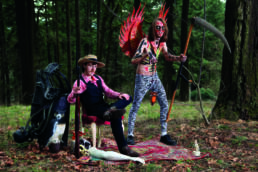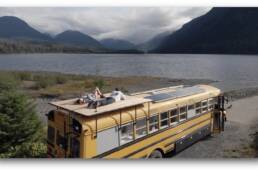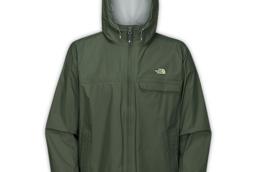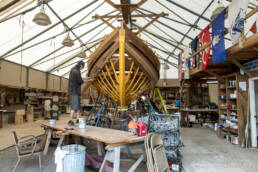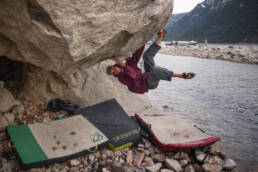Born from record bins, basements and Cascadia’s blue-collared past, the Pacific Northwest heavy-metal scene has torn a path all of its own since the 1980s. It’s fun. Ferocious. And even outright evil. It is music to your fears. By Jason Schreurs.
“You don’t want to go into that pit.”
I remember those words as vividly as if they were spoken to me today, and not in early 1991. My older, slightly wiser metalhead friend was warning me against entering a violent mosh at a downtown Vancouver, British Columbia, dive bar where Seattle’s “splatter-core” kings, The Accüsed, were ripping the room a new orifice. Standing back and fighting the urge to plunge my body into the extreme metal danger zone, I noticed someone stumbling out of the pit, hand at his face, bleeding profusely from his eye socket.
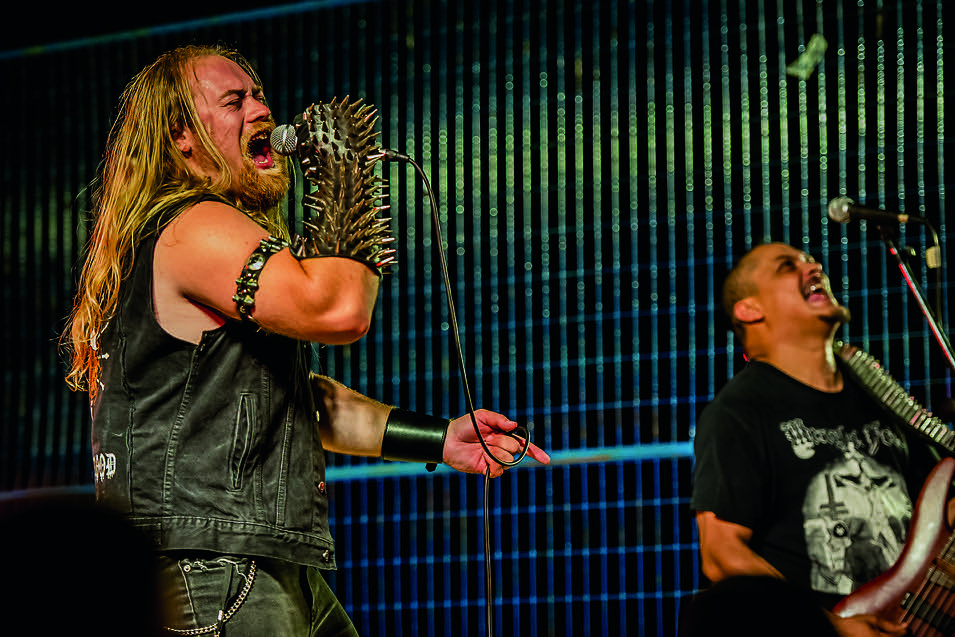
A few months later, my same metal mentor was leading me down the sketchy hallways of an abandoned warehouse in the worst part of Vancouver to see a death-metal band called Tumult, who had links to the infamous, self-proclaimed “satanic skinheads,” Blasphemy. Scared shitless and only 19, I was convinced I was getting injured that night. But instead of bodily harm, what I got was a true introduction to the extreme, underground Pacific Northwest heavy-metal scene that has stuck with me for more than 20 years.
This region shelters a heavy-metal community as tight knit as it is diverse in styles, such as death, thrash, stoner, doom, sludge and black. Born out of geographical isolation, the region’s scene is arguably more genuine and artistic than heavy-metal scenes around the globe.
 Heavy-metal lifers Adem Tepedelen and Greg Pratt have been part of the Pacific Northwest metal scene for as long as they can remember. Tepedelen grew up in Oregon, Pratt in British Columbia, and both have been huge fans of the coast’s metal scene since the 80s. Over the years they’ve also promoted gigs, hosted radio shows, played in bands, such as Hollow Instinct (Tepedelen) and Let’s Put the X in Sex (Pratt), and wrote for magazines such as Brave Words & Bloody Knuckles, Decibel and Metal Maniacs.
Heavy-metal lifers Adem Tepedelen and Greg Pratt have been part of the Pacific Northwest metal scene for as long as they can remember. Tepedelen grew up in Oregon, Pratt in British Columbia, and both have been huge fans of the coast’s metal scene since the 80s. Over the years they’ve also promoted gigs, hosted radio shows, played in bands, such as Hollow Instinct (Tepedelen) and Let’s Put the X in Sex (Pratt), and wrote for magazines such as Brave Words & Bloody Knuckles, Decibel and Metal Maniacs.
Metal has remained a huge part of their lives to this day; both Tepedelen and Pratt are now esteemed heavy-metal journalists. “The metal scene in the Pacific Northwest has always been self-supporting,” explains Tepedelen. “Local fans love their local bands, and bands tend to support each other. There isn’t a sound, but more an aesthetic. This is a scene that, for the most part, has embraced the role of underdog and has evolved accordingly.”
Pratt says what stands out about the region’s metal scene is “a twisted party vibe” that combines danger and fun. “Be it tales of Blasphemy getting up to no good in [Victoria, BC’s] Ross Bay Cemetery, or witnessing Goatsblood play a psychotic, self-destructive concert, even those things had an element of fun to them,” notes Pratt. “I guess we’re kind of damaged over here.
“When I think of the metal scene around here, I think laid-back, happy, fun, but serious about the tunes. That’s modern day, like Bison BC or Six Brew Bantha,” continues Pratt. “But historically, the Northwest was super-important in the development of really raw black metal, bordering on war metal, and really grim bestial black stuff. And that’s thanks to Blasphemy. They played a super-important role in truly scary, intense black metal and are recognized globally for it, for good reason.”
WHEN BLASPHEMY’S Blood Upon the Altar demo showed up in my childhood mailbox, I couldn’t believe what came out of my speakers. The Vancouver band recorded pure evil that sounded like it was recorded in a sarcophagus. My teenaged ears barely comprehended what they were hearing, but they loved it.
As scary as Blasphemy’s music was, the rumours of what was transpiring in real life were even scarier. There was talk of grave desecrations, cop murders, Satanism, drugs, sexual depravity; whatever the truth—and members of the band are keeping hush-hush about it—Blasphemy became the first Pacific Northwest metal band to cause a global reaction within the underground.
Marco Banco played guitar in Blasphemy between 1989 and 1993, a time when the band was the most frightening entity in Northwestern metal. Banco, who used the pseudonym Traditional Sodomizer of the Goddess of Perversity at the time, believes today’s Northwest metal scene has been saturated. Although strong in numbers, which includes his own Vancouver-based band Tyrant’s Blood, he says it’s hard to be original.
“The [Vancouver] scene started with three or four bands in the early 80s, then the second wave blew up to about two dozen groups up until now, where there are metal bands flooded throughout the city,” Banco explains. “I’ve been here since the beginning, so for me all the original energy is long gone. But hopefully somebody takes that blade and cuts a new path somewhere without simply ripping off old, tired ideals.”
While Pacific Northwest metal does have some of the stylistic trappings of scenes in metal hotbeds like New York and Sweden, it still benefits from the coastal solitude and adventurism of the west coast. In fact, there’s a whole movement coined “Cascadian metal” that takes the satanic black metal model but removes the Satan and adds in Mother Nature as the symbol of worship and lyrical inspiration. Led by Olympia, Washington’s Wolves in the Throne Room, although completely indulgent, the style is something different and very specific to the Northwest. And if the metal scene in the region started with the benefits of individualism, there’s no reason why bands can’t take advantage of them again.
“Like everything from the Northwest, before the region became what it is today, bands were more likely to do their own thing, more or less uninfluenced in a major way by whatever was going on in the rest of the musical world,” says Tepedelen. “The isolation of this region at the time was a good thing. Sure, these bands were fans of and influenced by the bigger hard-rock and metal bands of the day, but they all seemed to put their own unique Northwest spin on things. There wasn’t a Northwest metal sound, per se, but it tended to be less flashy and darker than its contemporaries. Before Amazon, Microsoft and Starbucks, this area was blue collar and the music reflected those roots.”
This region shelters a heavy-metal community as tight knit as it is diverse in styles, such as death, thrash, stoner, doom, sludge and black.
IN THE BACKYARD of Victoria grindcore band Six Brew Bantha, a collection of metalheads has gathered. Guzzling beers and chatting about their love of metal, adorned in black T-shirts with nearly indecipherable logos, they are anticipating a sweaty basement set from Portland’s crusty grinders Transient. There’s a badminton net that’s been set up in the yard and a couple of dudes are banging a birdie back and forth. This is a far cry from the dingy shows that got me into Pacific Northwest metal two decades ago, but the spirit is still the same. Everyone seems chill, but as soon as the basement lights are dimmed, the amps are cranked up and Transient unleash their metal-grind fury, that we’re-not-getting-out-of-here-alive feeling comes flooding back.
Pacific Northwest Metal still feels just as dangerous as it did when bands like The Accüsed and Blasphemy were wreaking havoc in sketchy warehouses and dive bars. But the difference is I’m not scared shitless anymore. I’m home.
Jason Schreurs is a Powell River, BC-based music and culture journalist. His greatest fear is permanent hearing loss.
Related Stories
Saving The Salish Sea in the Pacific Northwest
Two National Geographic photographers and marine biologists are trying to get the Salish Sea, which includes the Strait…
What’s More Badass Than a Honey Badger? These Guys. And They’re Returning to the Pacific Northwest.
A ferocious carnivore and old-growth forager, the fisher has been over-trapped and its habitat nearly wiped out. But in…
Is This The Coolest School Bus In The Pacific Northwest?
Louisa Gilbert of Wild Bus Films has turned a simple yellow school bus into an off-grid travelling palace. This is…
Of Vessels & Veritas At The Northwest School of Wooden Boatbuilding
The teachers at this esteemed Olympic Peninsula institution know that while owning a boat will change your life,…
Why The West Kootenay Bouldering Scene Is Blowing Up
On the heels of the announcement that Ladybird Creek Bouldering area in the Slocan Valley is now a BC Recreation Site,…


